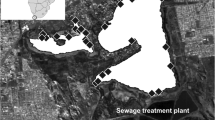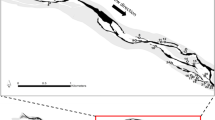Abstract
Current successional models, primarily those based on floral succession, propose several distinct trajectories based on the integration of two key hypotheses from succession theory: convergence versus divergence in species composition among successional sites, and progression towards versus deviation from a desired reference state. We applied this framework to faunal succession, including differential colonization between active and passive dispersers, and the nested patterns generated as a consequence of this peculiarity. Nine man-made wetlands located in three different areas, from 0–3 years from wetland creation, were assessed. In addition, 91 wetlands distributed throughout the region were used as references for natural macroinvertebrate communities. We predicted the following: (1) highly nested structures in pioneering assemblages will decrease to lower mid-term values due to a shift from active pioneering taxa to passive disperser ones; (2) passive idiosyncratic taxa will elicit divergent successional trajectories among areas; (3) the divergent trajectories will provoke lower local and higher regional diversity values in the mid-term assemblages than in pioneer assemblages. Our results were largely congruent with hypotheses (1) and (2), diverging from the anticipated patterns only in the case of the temporary wetlands area. However, overall diversity trends based on hypothesis (3) did not follow the expected pattern. The divergent successional trajectories did not compensate for regional biodiversity losses that occurred as a consequence of pioneering colonizer decline over time. Consequently, we suggest reconsidering wetland construction for mitigation purposes within mid-term time frames (≤3 years). Wetlands may not offset, within this temporal scenario, regional biodiversity loss because the ecosystem may not support idiosyncratic taxa from natural wetlands.







Similar content being viewed by others
References
Almeida-Neto M, Guimarães P, Guimarães PR, Loyola RD, Ulrich W (2008) A consistent metric for nestedness analysis in ecological systems: reconciling concept and measurement. Oikos 117:1227–1239. doi:10.1111/j.0030-1299.2008.16644.x
Anderson KJ (2007) Temporal patterns in rates of community change during succession. Am Nat 169:780–793. doi:10.1086/516653
Anderson MJ (2001) Permutation tests for univariate or multivariate analysis of variance and regression. Can J Fish Aquat Sci 58:626–639
Atmar W, Patterson B (1993) The measure of order and disorder in the distribution of species in fragmented habitat. Oecologia 96:373–382. doi:10.1007/bf00317508
Bagella S, Gascón S, Caria M, Sala J, Boix D (2011) Cross-taxon congruence in Mediterranean temporary wetlands: vascular plants, crustaceans, and coleopterans. Commun Ecol 12:40–50. doi:10.1556/ComEc.12.2011.1.6
Bascompte J, Jordano P, Melián CJ, Olesen JM (2003) The nested assembly of plant–animal mutualistic networks. Proc Natl Acad Sci USA 100:9383–9387. doi:10.1073/pnas.1633576100
Baselga A (2010) Partitioning the turnover and nestedness components of beta diversity. Glob Ecol Biogeogr 19:134–143. doi:10.1111/j.1466-8238.2009.00490.x
Batzer DP, Wissinger SA (1996) Ecology of insect communities in nontidal wetlands. Annu Rev Entomol 41:75–100
Bilton DT et al (2009) Ecology and conservation status of temporary and fluctuating ponds in two areas of southern England. Aquat Conserv Mar Freshw Ecosyst 19:134–146. doi:10.1002/aqc.973
Bloch CP, Higgins CL, Willig MR (2007) Effects of large-scale disturbance on metacommunity structure of terrestrial gastropods: temporal trends in nestedness. Oikos 116:395–406. doi:10.1111/j.0030-1299.2007.15391.x
Bloechl A, Koenemann S, Philippi B, Melber A (2010) Abundance, diversity and succession of aquatic Coleoptera and Heteroptera in a cluster of artificial ponds in the North German Lowlands. Limnologica 40:215–225. doi:10.1016/j.limno.2009.08.001
Boix D, Gascón S, Sala J, Badosa A, Brucet S, López-Flores R, Martinoy M, Gifre J, Quintana XD (2008) Patterns of composition and species richness of crustaceans and aquatic insects along environmental gradients in Mediterranean water bodies. Hydrobiologia 597:53–69. doi:10.1007/s10750-007-9221-z
Chase JM (2007) Drought mediates the importance of stochastic community assembly. Proc Natl Acad Sci 104:17430–17434. doi:10.1073/pnas.0704350104
Christensen NL, Peet RK (1984) Convergence during secondary forest succession. J Ecol 72:25–36
Clements FE (1936) The nature and structure of the climax. J Ecol 24:252–284
Connell JH, Slatyer RO (1977) Mechanisms of succession in natural communities and their role in community stability and organization. Am Nat 111:1119–1144
Cook RR (1995) The relationship between nested subsets, habitat subdivision, and species diversity. Oecologia 101:204–210. doi:10.1007/bf00317285
Crawley M (2007) The R book. John Wiley and Sons Ltd., Chichester, UK
Crist TO, Veech JA, Gering JC, Summerville KS (2003) Partitioning species diversity across landscapes and regions: a hierarchical analysis of α, β, and γ diversity. Am Nat 162:734–743. doi:10.1086/378901
de Eyto E, Irvine K (2007) Assessing the status of shallow lakes using an additive model of biomass size spectra. Aquat Conserv Mar Freshw Ecosyst 17:724–736. doi:10.1002/aqc.801
del Moral R (2007) Limits to convergence of vegetation during early primary succession. J Veg Sci 18:479–488. doi:10.1111/j.1654-1103.2007.tb02562.x
Fairchild GW, Faulds AM, Matta JF (2000) Beetle assemblages in ponds: effects of habitat and site age. Freshw Biol 44:523–534. doi:10.1046/j.1365-2427.2000.00601.x
Florencio M, Díaz-Paniagua C, Serrano L, Bilton D (2011) Spatio-temporal nested patterns in macroinvertebrate assemblages across a pond network with a wide hydroperiod range. Oecologia 166:469–483. doi:10.1007/s00442-010-1847-2
Gee JHR, Smith BD, Lee KM, Griffiths SW (1997) The ecological basis of freshwater pond management for biodiversity. Aquat Conserv Mar Freshw Ecosyst 7:91–104. doi:10.1002/(sici)1099-0755(199706)7:2<91:aid-aqc221>3.0.co;2-o
Gotelli NJ, Colwell RK (2001) Quantifying biodiversity: procedures and pitfalls in the measurement and comparison of species richness. Ecol Lett 4:379–391. doi:10.1046/j.1461-0248.2001.00230.x
Grasshoff K, Kremling K, Ehrhardt M (1983) Methods of seawater analysis. Verlag Chemie, Weinheim
Guimarães JPR, Guimarães P (2006) Improving the analyses of nestedness for large sets of matrices. Environ Model Softw 21:1512–1513. doi:10.1016/j.envsoft.2006.04.002
Gutierrez LT, Fey WR (1980) Ecosystem succession: a general hypothesis and a test model of a grassland. MIT Press, Cambridge
Heck KL, van Belle G, Simberloff D (1975) Explicit calculation of the rarefaction diversity measurement and the determination of sufficient sample size. Ecology 56:1459–1461
Heino J, Soininen J, Lappalainen J, Virtanen R (2005) The relationship between species richness and taxonomic distinctness in freshwater organisms. Limnol Oceanogr 50:978–986
Herrmann J, Boström A, Bohman I (2000) Invertebrate colonisation into the man-made Kalmar Dämme wetland dam system. Verh Int Ver Theor Angew Limnol 27:1653–1656
Hieber M, Robinson CT, Uehlinger URS, Ward JV (2005) A comparison of benthic macroinvertebrate assemblages among different types of alpine streams. Freshw Biol 50:2087–2100. doi:10.1111/j.1365-2427.2005.01460.x
Jackson JK, Füreder L (2006) Long-term studies of freshwater macroinvertebrates: a review of the frequency, duration and ecological significance. Freshw Biol 51:591–603. doi:10.1111/j.1365-2427.2006.01503.x
Jeffries M (1991) The ecology and conservation value of forestry ponds in Scotland, United Kingdom. Biol Conserv 58:191–211. doi:10.1016/0006-3207(91)90119-t
Jeffries M (1994) Invertebrate communities and turnover in wetland ponds affected by drought. Freshw Biol 32:603–612. doi:10.1111/j.1365-2427.1994.tb01151.x
Jeffries M (2011) The temporal dynamics of temporary pond macroinvertebrate communities over a 10-year period. Hydrobiologia 661:391–405. doi:10.1007/s10750-010-0551-x
Jenkins DG, Brescacin CR, Duxbury CV, Elliott JA, Evans JA et al (2007) Does size matter for dispersal distance? Glob Ecol Biogeogr 16:415–425. doi:10.1111/j.1466-8238.2007.00312.x
Koskenniemi E (1994) Colonization, succession and environmental conditions of the macrozoobenthos in a regulated, polyhumic reservoir, Western Finland. Int Rev Gesamten Hydrobiol 79:521–555
Legendre P, Borcard D, Peres-Neto PR (2005) Analyzing beta diversity: partitioning the spatial variation of community composition data. Ecol Monogr 75:435–450. doi:10.1890/05-0549
Lesbarrères D, Fowler MS, Pagano A, Lodé T (2010) Recovery of anuran community diversity following habitat replacement. J Appl Ecol 47:148–156. doi:10.1111/j.1365-2664.2009.01748.x
Lods-Crozet B, Castella E (2009) Colonisation by midges (Chironomidae, Diptera) of recently-created shallow ponds: implications for the restoration of lacustrine fringing wetlands. Ann Limnol 45:257–266
Loo SE, MacNally RM, Quinn GP (2002) An experimental examination of colonization as a generator of biotic nestedness. Oecologia 132:118–124. doi:10.1007/s00442-002-0933-5
Matthews JW, Spyreas G (2010) Convergence and divergence in plant community trajectories as a framework for monitoring wetland restoration progress. J Appl Ecol 47:1128–1136. doi:10.1111/j.1365-2664.2010.01862.x
McAbendroth L, Foggo A, Rundle SD, Bilton DT (2005) Unravelling nestedness and spatial pattern in pond assemblages. J Anim Ecol 74:41–49. doi:10.1111/j.1365-2656.2004.00895.x
Mitsch WJ, Wilson RF (1996) Improving the success of wetland creation and restoration with know-how, time, and self-design. Ecol Appl 6:77–83
Mitsuo Y, Tsunoda H, Ohira M, Doi M, Senga Y (2011) Nested subset patterns of species composition in a pond-dwelling fish fauna. Ecol Res 26:311–316. doi:10.1007/s11284-010-0785-0
Odum EP (1960) Organic production and turnover in old field succession. Ecology 41:34–49
Oertli B, Auderset Joye D, Castella E, Juge R, Cambin D, Lachavanne J-B (2002) Does size matter? The relationship between pond area and biodiversity. Biol Conserv 104:59–70. doi:10.1016/S0006-3207(01)00154-9
Oksanen J, Blanchet FG, Kindt R, Legendre P, O’Hara RB, Simpson GL, Solymos P, Stevens MHH, Wagner H (2010) Vegan package v. 1.17-3. Available at: http://cc.oulu.fi/~jarioksa/softhelp/vegan.html
Patterson BD (1990) On the temporal development of nested subset patterns of species composition. Oikos 59:330–342
Pechmann J, Estes R, Scott D, Gibbons J (2001) Amphibian colonization and use of ponds created for trial mitigation of wetland loss. Wetlands 21:93–111. doi:10.1672/0277-5212(2001)
Pineda FD, Nicolas JP, Rou A, Galiano EF (1981) Ecological succession in oligotrophic pastures of central Spain. Plant Ecol 44:165–176. doi:10.1007/bf00156626
Ruhí A, Boix D, Sala J, Gascon S, Quintana XD (2009) Spatial and temporal patterns of pioneer macrofauna in recently created ponds: taxonomic and functional approaches. Hydrobiologia 634:137–151. doi:10.1007/s10750-009-9896-4
Ruhí A, Herrmann M, Gascón S, Sala J, Geijer J, Boix D (2012) Change in biological traits and community structure of macroinvertebrates through primary succession in a man-made Swedish wetland. Freshw Sci 31:22–37. doi:10.1899/11-018.1
Rundle SD, Foggo A, Choiseul V, Bilton DT (2002) Are distribution patterns linked to dispersal mechanism? An investigation using pond invertebrate assemblages. Freshw Biol 47:1571–1581. doi:10.1046/j.1365-2427.2002.00886.x
Santos LN, García-Berthou E, Agostinho AA, Latini JD (2011) Fish colonization of artificial reefs in a large Neotropical reservoir: material type and successional changes. Ecol Appl 21:251–262. doi:10.1890/09-1283.1
Scheffer M, Geest GJ, Zimmer K, Jeppesen E, Sondergaard M et al (2006) Small habitat size and isolation can promote species richness: second-order effects on biodiversity in shallow lakes and ponds. Oikos 112:227–231. doi:10.1111/j.0030-1299.2006.14145.x
Seabloom EW, Van Der Valk AG (2003) The development of vegetative zonation patterns in restored prairie pothole wetlands. J Appl Ecol 40:92–100. doi:10.1046/j.1365-2664.2003.00764.x
Stendera SES, Johnson RK (2005) Additive partitioning of aquatic invertebrate species diversity across multiple spatial scales. Freshw Biol 50:1360–1375. doi:10.1111/j.1365-2427.2005.01403.x
Talling JF, Driver D (1963) Some problems in the estimation of chlorophyll a in phytoplankton. In: Proc Conf Primary Productivity Measurements, Marine and Freshwater. US Atomic Energy Commission,
Tuomisto H (2010a) A diversity of beta diversities: straightening up a concept gone awry. Part 1. Defining beta diversity as a function of alpha and gamma diversity. Ecography 33:2–22. doi:10.1111/j.1600-0587.2009.05880.x
Tuomisto H (2010b) A diversity of beta diversities: straightening up a concept gone awry. Part 2. Quantifying beta diversity and related phenomena. Ecography 33:23–45. doi:10.1111/j.1600-0587.2009.06148.x
Williams P, Whitfield M, Biggs J (2008) How can we make new ponds biodiverse? A case study monitored over 7 years. Hydrobiologia 597:137–148. doi:10.1007/s10750-007-9224-9
Wissinger SA, Greig H, McIntosh A (2008) Absence of species replacements between permanent and temporary lentic communities in New Zealand. J North Am Benthol Soc 28:12–23. doi:10.1899/08-007.1
Wood SN (2001) mgcv: GAMs and generalized ridge regression for R. R News 1:20–25
Zilli F, Marchese M (2011) Patterns in macroinvertebrate assemblages at different spatial scales. Implications of hydrological connectivity in a large floodplain river. Hydrobiologia 663:245–257. doi:10.1007/s10750-010-0576-1
Acknowledgments
We wish to thank the handling editor Dr. Pedro Peres-Neto, and two anonymous reviewers, for constructive suggestions that improved the manuscript. This study was funded by the Spanish Ministry of Science and Innovation (Project CGL2011-23907), and Albert Ruhí held a FPU doctoral fellowship from the Spanish Ministry of Education (AP2006-00807). We would like to thank Mònica Martinoy and Jaume Gifre for field and laboratory assistance, and Núria Pla for her help in editing the figures.
Author information
Authors and Affiliations
Corresponding author
Additional information
Communicated by Pedro Peres-Neto.
Electronic supplementary material
Below is the link to the electronic supplementary material.
Rights and permissions
About this article
Cite this article
Ruhí, A., Boix, D., Gascón, S. et al. Nestedness and successional trajectories of macroinvertebrate assemblages in man-made wetlands. Oecologia 171, 545–556 (2013). https://doi.org/10.1007/s00442-012-2440-7
Received:
Accepted:
Published:
Issue Date:
DOI: https://doi.org/10.1007/s00442-012-2440-7




